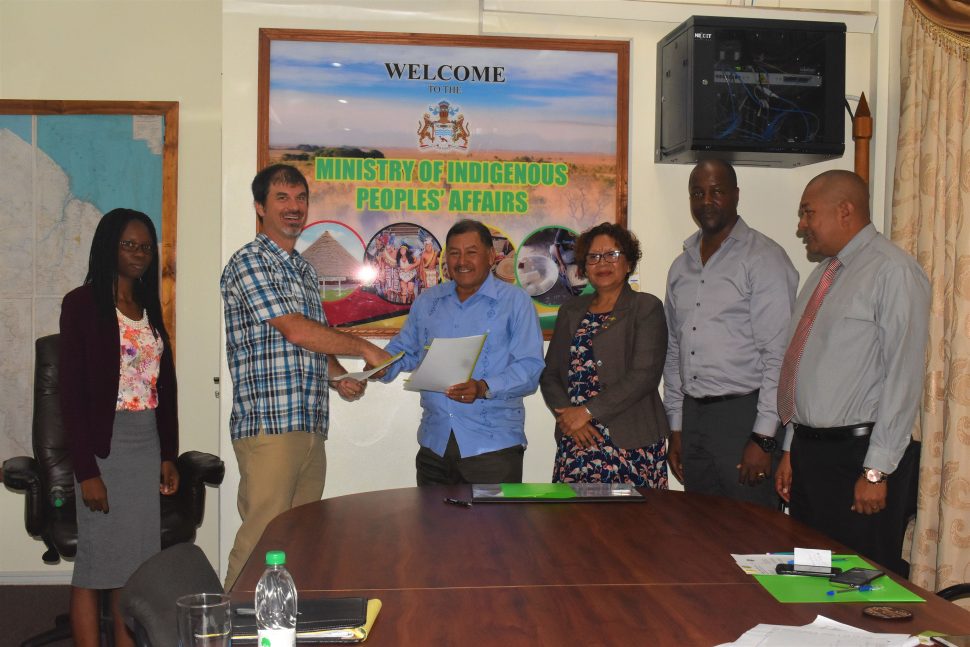The Ministry of Indi-genous Peoples’ Affairs and the Guyana Tourism Authority (GTA) on Wednesday signed a Mem-orandum of Unders-tanding (MoU) to work together towards the development of sustainable community-based tourism models in Guyana’s hinterland.
Speaking at the signing, Permanent Secretary of the Ministry Alfred King said the agreement is expected to formalise the work that the two agencies have already started.
King noted, too, that it is the ministry’s intention, through its numerous programmes and activities, to empower communities to take responsibility for their own development and livelihood, including tourism based activi-ties. “The signing of the MoU will see us entering into a more structured agreement where our roles and responsibilities are laid out, what it is the ministry wants to do to enhance these tourism projects that we are embarking on and from a policy standpoint, how the ministers will want to continue to focus some attention and give better direction to ensure that these torusim packages grow and develop into real sustainable activities,” King said.
Meanwhile, Minister within the Ministry of Indi-genous Peoples’ Affairs Valerie Garrido-Lowe, who was also present, emphasised the importance of collaboration, particularly in the interest of ensuring strategic development within hinterland com-munities. “To cater for our 80,000 indigenous persons within the hinterland communities, it is quite a challenge for the ministry alone. So being a one government, we collaborate with each other so we can really see how to target communities or whatever we want to do so that we can achieve that goal,” the minister said.
She noted, too, that though it is the duty of the government to provide services, such as education and health, there must be political will to address the economic needs of these communities, which she says has been a mandate of the present government.
Additionally, Garrido-Lowe said even as Guyana prepares to welcome the benefits of oil production, there is still a need for other avenues for economic development. “The ministry is proud to play a part along with the GTA to really get tourism going on its way. This is Guyana’s second oil,” she added.
President of the GTA Brian Mullis, in his remarks, said Guyana has a great deal of pristine rainforest and ecosystems, with the indigenous peoples serving as their guardians.
“People are attracted to nature and authentic cultural experiences—that… is really the number one attractor for travellers who are interested in what we have to offer. At the same time, that uniquely differentiates [us] from most other destinations in the world,” he said.
Mullis also contended that community-based tourism is a unique phenomenon in Guyana, and there is a higher level of market success when compared to models in other parts of the world.
“It has been the vision of the ministry to scale that up. How do we take efforts like Surama, which took decades, and turn that into several years where communities can be successful with tourism? It is for these reasons I feel like the most important partnership with the sister governmental agency that the GTA can have is with the Ministry of Indigenous Peoples’ Affairs,” he added.
“In order to achieve economic sustainability they spoke of, we want to leverage that past investment, which has been significant in tourism and indigenous communities, so that those communities can be linked to the tourism value chain,” he further said.
The ministry and the GTA worked together earlier this year to identify and prioritise communities in all 10 regions based on past investments, market access, strategic visitor flow and market demand.
Mullis said by going through that process, they were able to look at resource alignment through both agencies and determine where they could maximise outcomes. “We started with four communities… Moraikobai, Karasabai, Chenapau and Warapoka because we felt they were the closest to being ready to accept visitors…. Our ultimate aim with these four communities is to get them linked with the tourism value chain, where they are accepting visitors and we know that it is going to take more training and collaboration with one another and we have been engaging with some fund raising activities because development agencies are very interested in supporting this type of work,” he noted.
“It really is this formalised collaboration agreement mechanism that will enable us to do more together than we have in the past. Ultimately, it has aligned us with the Green State Development Strategy and we have been informed by our colleagues at the United Nations that the number one mechanism for achieving the Green State Development Strategy is alignment and collaboration. So I do think that exemplifies this,” Mullis added.
Meanwhile, Minister of Indigenous Peoples’ Affairs Sydney Allicock, who also present at the signing, said the positives of community-based tourism have been seen within a short period and that is why there was need to sign the agreement. “It is about resources, human and financial resources, that need to be put together so we get maximum outcome of the resources at hand,” he said. “Warapoka is a living example of what we have started. It’s been two and half years we have been working with them and they have taken off and that is going to be replicated in other communities that are awaiting this eventuality. We have the commodity and the GTA has the expertise and sometimes the funding to give that support for success,” he added.








